Nile Basin peatlands and climate change

The government is taking measures to cushion Kenyans against adverse climatic conditions. PHOTO | CHRISPUS BARGORETT.
Kenya has been experiencing dramatic weather patterns with repercussions ranging from increased temperatures, floods, droughts and an increase of diseases. With the government taking measures to cushion Kenyans against adverse climatic conditions, a study to assess the role of Nile Basin peatlands in climate change is being done by the Nile Basin Initiative (NBI). During a four-day meeting held recently in Nairobi, experts reviewed information from the regional-based study to enhance data, information and knowledge about such wetlands so as to support sustainable management and utilisation of the ecosystem, said Dr Abdulkarim Seid Deputy Executive Director of the NBI Secretariat and head of programmes at NBI.
Peatlands have the ability to contain (lock) one of the four major greenhouse gases (GHGs), Carbon dioxide (CO2), and also to release the gas in large quantities if they are destroyed. According to definitions, “peatlands are areas where partly decomposed wood from dense swamp forests have built up into soggy mounds of organic matter.” They stretch for kilometres and have a depth of several metres from the earth’s surface. They are of different forms which include open, treeless vegetation and forest swamps (bogs).
NOT ENOUGH INFORMATION
Unfortunately, there is limited information about peatlands along the Nile Basin, “We are collecting a lot of information about these peatlands because one of the problems in the Nile Basin is that there is less information about these wetlands,” said Leonard Akwany, Regional Wetlands Expert for the Nile Basin secretariat based in Entebbe, Uganda. The assessment includes “calculating the current carbon stock in the basin and estimating the carbon dioxide emissions from drained use”. The study is expected to generate technical and policy discussions on how to avoid GHG emissions from these peatlands. Peatlands preserve global biodiversity, provide safe drinking water, minimise flood risk and help address climate change, said Mr Akwany.
They store more carbon dioxide than all vegetation types in the world combined (0.37 gigatonnes a year), but when damaged through human activities which include agriculture, infrastructural development, drainage and mining, they release six per cent of global CO2 emissions yearly. Greenhouse gases are responsible for global warming and climate change, two issues of global concern, especially because of catastrophic effects of flooding, drought and rising seas and disease outbreaks. According to Mr Akwany, the work which is being done is at the centre of solving water scarcity in the region (Nile basin). “Conserving these wetlands and ensuring that they are sustainable or ensuring that they continue delivering the benefits we get from them is very important. We want to ensure that they continue being there to continue being sources of water for River Nile,” he said.
COLLABORATION
One type of information being generated is about where these wetlands are and the extent of their existence detailed in an inventory in an atlas form, information which will be used for planning at the river level. As such, Kenya is collaborating with Uganda on the trans-boundary wetland between them given that the Nile originates from Lake Victoria, which is shared by Kenya, Uganda and Tanzania. Among the rivers draining to the lake is the Mara River whose source is the Mau Forest in Kenya.“We are developing a plan for the management of this wetland and have mapped peatlands on it. All the countries within the Nile are really benefiting from the work,” said Mr Akwany. Kenya is one of the ten countries under the NBI including Egypt, Ethiopia, Rwanda, South Sudan, Sudan, Tanzania and Uganda.


